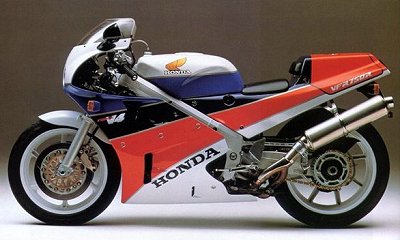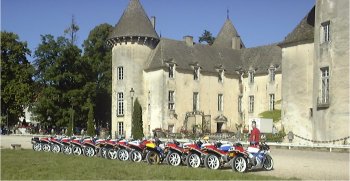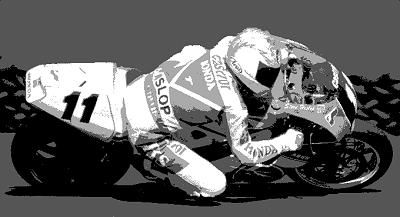Honda VFR750R RC30

Image from the original brochure
The RC30 was the first race-replica that was also a real racer - a homologation machine for Formula1 and World Superbikes. It was a street bike based on Honda's successful RVF superbike and endurance racer. It won the World Superbike championship in its first two years, and was the vehicle of choice for Superbike, endurance and TT racers for years. In fact, RC30s have been spotted doing stalwart work at the Isle of Man even in the late 90's.
The RC30 reviewed way back in 1991...
Everything about the bike is so uncompromising; it looks illegal standing still and when you get on it laws cease to exist. It's all to do with minimalism. Less IS more.You'd be in the queue behind me, matey boy! Another review, this time from 1989, comparing it with the then-new ZXR750:
The Most Important Thing about this bike it its engine. It starts pulling from nowhere and at seven thousand revs growls at you. It heaves and moans and judders for a thousand revs, then goes quiet again, but pulls harder. And then, at 11,000 a hundred screaming maniacs howl at you and you get pushed.
Did I like it? Do bears go tra la la la in the woods? If I had the cash I'd definitely buy one.
I can only equate the feel of this bike to that of an RGV250 [probably the best-handling bike of the day] with a VFR750 motor. Whereas the ZXR makes no pretentions to being a proper race bike the RC30 does nothing to hide its racetrack breeding.The RC30 was considered to be ineffective against the competition by 1992. The Yamaha YZF750 won the British Superbike championship in 1993, in the hands of Jamie Whitham, but on the other side of the world Troy Corser was showing them how it was done. He won the 1993 Australian Superbike championship on an RC30, there is a pic here. Troy Corser website is at www.troycorser.com.
The trouble with the RC30 is it takes even average bozos like me to levels where we don't belong. I never imagined that a bike could be this together.
On the Isle of Man the RC30 provided Honda with many wins. In 1988 Steve Hislop broke the Production class record by 15 seconds, from a standing start, while Joey Dunlop broke his own absolute record (at a speed of 118.54mph) on essentially the same machine with a few race kit parts. In 1989 Hislop dominated the TT in Joey's absence, setting the first sub-20 minute, 120mph-plus lap on an RVF - again from a standing start. Brian Morrison and Carl Fogarty both managed 120mph-plus laps aboard RC30s in the same week.
By 1990 the RC30 dominated the entries for the TT. 15 of the 25 finishers in the Formula 1 and all but 3 of the 19 completing the Senior were on RC30s. Fogarty took the Formula 1, while Hislop pushed the lap record to 122.63mph. In 1991 special factory RVFs were brought over, and Hizzy and Carl swapped fastest times through practice week in a phenomenal psychological battle. Hizzy's 124.4mph lap wasn't beaten until 1999 by Jim Moodie on an RC45. Jim later said he could have gone even faster if he had an RC like the one he rode at the Suzuka 8 hours. Blimey!
Ten years after its introduction (Dec 98) Performance Bikes thought a stock RC30 would benefit from a very short list of changes to bring it up to date (if you feel the need). Here's a list of suggestions:
A stocker only knocks out 90 horsepower-wise, the OE discs warp at the merest mention of the word stop and an 18 inch rear wheel is not the thing to have if you want a choice of more than two sticky tyres.Note: Tony Scott is a V4 tuner par excellence. His skills have been in demand by race teams and privateers for a good while now, and he is known as the man who gets the best from the Honda V4 race engines. If you want the best, Tony Scott is your man.
The motor goes to Tony Scott for a fettle. A shade over a grand gets you a blueprint and 120 reliable bhp with a race pipe. New discs are £250 touch for the pair, or around £750 for new aftermarket everything (discs, calipers, lines and master cylinder). A decent rear wheel will be £500 (a front wants to be a 3.5in rim, not a 3in if you've money to burn) and suddenly you've spent more than three grand on top of the seven already shelled out. And that's before the rear ride height adjuster and fork mods (the one-way valves in the cartridges are naughty).
No, what you do is lie in wait for a house purchase/baby/illness forces sale item that's already had money thrown at it. You then have one of the sweetest sickles ever nailed into a crate. Old it may be, old hat it ain't.
MCN Buying Guide
Motorcycle News' buying guide for the RC30 begins with a bold but accurate statement:The Honda RC30 goes beyond cult status. It is a legend. There is no other bike on the planet that means so much and so rapidly reduces normal riders to gibbering wrecks at the thought of owning one.How did they know? OK, I admit it. This is my dream bike. So, they ask, why is it so special? Some of the paragraphs above might explain this, but the article point out some of the features that make it so desirable:
Only 1,000 bikes were sold to the Japanese market, by drawing lots. They were restricted to 77bhp and a rev ceiling of 9,500rpm. They can be identified by the small headlights and black mirrors (all others are white). To derestrict one you need a new black box, exhaust end can, the carbs need re-jetting and the airbox must be modified. For 1990 a special run of about 300 RC30s were assembled for the U.S. market. They are fitted with air pollution controls and have the RC30 designation on the tail section.
RC30 still most desirable
For it's "Japan special" issue in January 2003 MCN highlighted the four best bikes ever to come from Japan. The RC30 was unanimously voted top machine, the text beside the big photo said:"No other bike comes close in the desirability stakes. Its handling is as much a revelation as it was back in the late eighties. 'Planted' is an overused word - but that's just how it is. The RC30 cossets you into piling into turns a lot harder than you'd think. Today's sports bikes likes the R1 and Fireblade are lighter and faster, but an RC30, even with its 42bhp power disadvantage, can still rock with the best."The other three bikes: Honda Fireblade, Kawasaki Z1 and Yamaha RD350LC. All groundbreaking machines, but even the mighty Fireblade cannot match the RC30's pedigree.
Here is a lovely image borrowed with permission from the RC30 Club de France - wish I'd been there.

Below is Steve Hislop aboard the Castrol RC30 at Oulton Park, 1993
© Simon J Evans

Click the image for a larger version
(680x369, 41kb)
| VFR750R RC30 | |
| Front tyre Rear tyre Wheelbase Rake/trail Dry weight Power Torque Fuel tank |
120/70 (17" rim) 170/60 (18" rim) 1410mm 24.5°/91mm 185kg 94bhp @ 11,300rpm 47 lb-ft @ 9,800rpm 20 litres |
Related sites
Julian Ryder's book Honda's V-force (local link) discusses the RC30 at length.
Geoff Infield's RC30 pages
RC30 Yahoo Group
An RC30 parts catalogue, 1991 Race Kit manual and Service data information can be viewed here
RC30 site with English text from Japan
Japanese RC30 Owners' Club (Japanese text)
A modern classic (French text)
Geoff Infield's RC30 pages
RC30 Yahoo Group
An RC30 parts catalogue, 1991 Race Kit manual and Service data information can be viewed here
RC30 site with English text from Japan
Japanese RC30 Owners' Club (Japanese text)
A modern classic (French text)